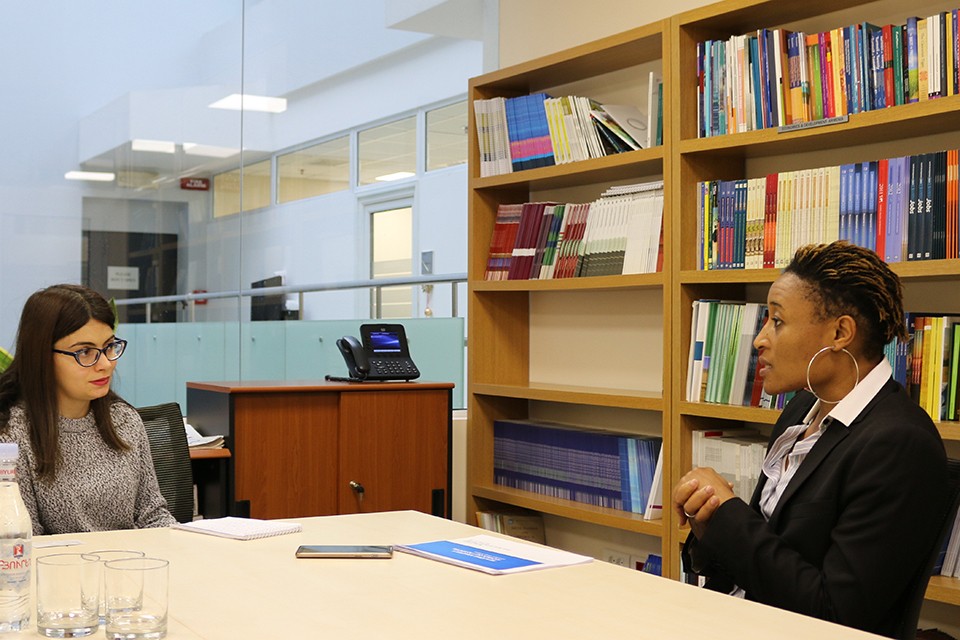-

Ifeyinwa Onugha
-

Narine Daneghyan and Ifeyinwa Onugha
16:59 | 20.12.19 | Articles | exclusive 224117
World Bank expert: “Armenian companies should look for global niche sectors”
The World Bank’s new “Realizing Armenia’s Technology Potential” report was released and officially presented last week in Yerevan.
The official event brought together over 60 representatives from various institutions of the Government of Armenia, private sector, key IT companies and associations for policy dialogue and technical discussions on actions that can help catalyze the development of high-tech sectors in Armenia in line with the development of global value high-tech chains.
The author of the report Ifeyinwa Onugha, the World Bank Private Sector Specialist, has shared some insights with Itel.am.
Finding value creation model to keep it in Armenia
We wrote the report between February and August 2019. While conducting the research, all local companies were open and welcoming. The challenge was that Armenians are naturally proud, excited and they have a very optimistic view, so when a newcomer like me comes and asks where the challenges are, it takes time to for them to open up.
The purpose of the research was to recognize that the world is changing; we have seen the global value chains of various high-tech sectors really start to shift. We wanted to see what the shape of those new value chains are, understand where the value is created, who captures the value, and who wins. When we really have answers to those questions, we will be able to identify where Armenia can come in and create the value.
Armenia has a very exciting story when it comes to ICT growth over the last 20 years. A lot of success comes from outsourcing, and that’s great, as it’s a proven growth model, especially for ICT services.
But we can’t deny the fact that the outsourcing model is certainly going to change as low-cost centers build their own capacity. Also, there will be competition from automation. We want to make sure that Armenia is protected and ready to face the next challenge.
Armenia is missing real opportunities
When we have a look at the local activities of some global powerhouses like Synopsys and Mentor Graphics; though the knowledge transfer and job creation is unrivalled, we also see that value that is created inside Armenia is ultimately invested outside of the country. It is important to find a model that will create value, retain it in Armenia, and grow the Armenian ecosystem (in addition to the classis subsidiary model).
Additionally, having an education strategy that is independent from high tech industry’s strategy doesn’t make sense to us. This really is the time for industry and education to come together and synchronize their strategies. If not, we will see good opportunities lost to regional competitors. As an example, PicsArt recently opened an AI lab in Moscow, specifically to leverage the PhD program of the Moscow Institute of Physics and Technology.
 Narine Daneghyan and Ifeyinwa Onugha
Narine Daneghyan and Ifeyinwa Onugha
Armenian companies should look for global niche sectors
What we have found was that the ICT industry in Armenia is very exciting, eager and has good connections with diaspora. But they are focusing on mass market solutions, industries that are very vast with a high degree of competition. Armenia doesn’t necessarily have comparative advantage in these sectors and is very difficult to distinguish yourself from the competition. Examples would be HR management software, lifestyle applications, banking software, etc. Why is Armenia better able to provide health management software to a hospital in San Diego, then a software provider based in the same city, the same time zone, and who is able to visit that hospital every day and understand issues that need to be addressed?
Armenian companies should look for global niche sectors; sectors where Armenians may have factor conditions that gives firm comparative advantage. We found a few directions like Biotech, Cleantech, Earthquake engineering, AI and Quantum Computing. Some people may laugh at the idea of Armenia excelling in Quantum Computing, but I am not talking about building quantum computers. Armenia is performing well in physics and nuclear energy research and areas like noise and error reduction, as well as software applications that build on various cloud quantum prototypes are definitely a viable option for Armenian firms. IBM, Google, Amazon, etc. are all investing in quantum computing. There are also firms who realize that there is an opportunity to bring quantum computing into their applications and start to invest.
If Armenians can create a community, information sharing, research programs, there is just no reason why Armenia can’t become a game changer in abovementioned directions.
Original analysis with actionable recommendations
This is an original analysis with actionable recommendations. Our client for this research was the Ministry of High-Tech Industry. Our goal is to create the right ecosystem and to let the private sector move and develop independently. That said, there are a lot of private sector institutions working in this space too, for example, Enterprise Incubator Foundation. Additionally, our colleagues at International Finance Corporation (IFC) will be using this report as a launchpad for doing sector scan of the Armenian ICT.
I would like to thank the community that let me in. I am grateful for the help and I am looking forward to the next stage.
Narine Daneghyan talked to Ifeyinwa Onugha

17:29 | 24.09.25 | Articles
Jacopo Losso on Cross-Border Investments and Why Armenia Attracts Angels








